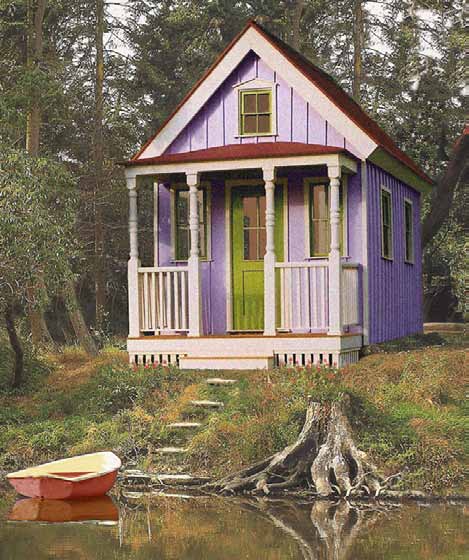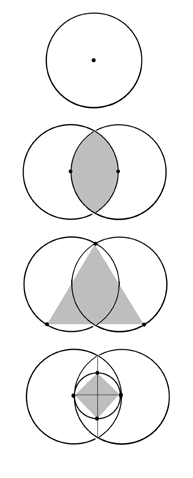The Small House Book (11 page)
Read The Small House Book Online
Authors: Jay Shafer

The phrase “E Pluribus Unum” (from many, one) appears elsewhere on the
bill along with no less than three other references to the archetype.
The common gable with a window at its center is vernacular architecture’s
one-eyed pyramid. The duality of its two sides converging at their singular
peak represents divinity, and is again underscored by a single central win-
dow. All of this rests on four walls, which are universally symbolic of the
cosmos.
85

Tumbleweed Tiny House Company’s Epu with the wheels removed.
86

Form and Number
The meaning of numbers and shapes
is as universal as the use of the shapes
themselves. Those that turn up in nature
most often, like circles, squares, 1, 1.6, 2,
3, 4, 12 and 28 tend to be the most sym-
bolically loaded.
ONE
One
is a single point without dimension,
typically represented by the circle created
when a line is drawn around the point with
a compass. One symbolizes the divine
through its singularity.
TWO
Two
adds dimension through the addition
of a second point. It is commonly depicted
by the Vesica Piscis shape that occurs
when two circles overlap. It represents
duality and creativity.
Three
brings balance back to two. It is
THREE
represented by the triangle and symbol-
izes variations on the Trinity.
Four,
as embodied by the square, typi-
cally represents the world we live in, with
its four cardinal directions.
FOUR
87
Organizing Principles
The success of a work of art hinges, more than anything else, on the strength
of its composition. Here the term “composition” is used to mean “a whole
comprised of parts.” A strong composition is one in which all its parts work to
strengthen the whole. This is as true of a piece of music as it is of a painting
or the design of a small house.
The last chapter described subtractive design as the means to distilling a
house to its essential components. This chapter will focus primarily on how
the remaining parts are to be organized into a comprehensive whole. Seven
principles: simplicity, honesty, proportion, scale, alignment, hierarchy and
procession will be presented as essential considerations to meeting this end.
Simplicity
It is ironic that simplicity is by far the most difficult of the seven principles to
achieve. Simplification is a complicated process. It demands that every pro-
portion and axis be painstakingly honed and that every remaining detail be
absolutely essential. The more simplified a design becomes; the more any
imperfection is going to stand out. Everything in a plain design must make
sense, because every little thing means so much. The result of this arduous
effort will look like something a child could come up with. The most refined art
always looks as if it had been easy to achieve.
This sort of streamlining demands a firm understanding of what is neces-
sary to a home. As stated before, there is no room in an honest dwelling for
anything apart from what truly makes its occupant(s) happy. Each one of us
must ultimately decide what this is and is not for ourselves. But, as with all
good vernacular processes, we should first consider the findings of those
88
who have gone before us. While our domestic needs will differ as much as
our location and circumstances, a look at what others consider to be impor-
tant can get us going in the right direction.
Ideas about what is indispensable to a home can be concise so long as
they are kept abstract. Consider Cicero’s claim: “If you have a garden and
a library, you have everything you need.” And William Morris’ sage advice:
“Have nothing in your houses that you do not know to be useful, or believe
to be beautiful.” More pragmatic lists tend to be a bit longer. Small house ad-
vocate, Ron Konzak, is helpful. In his essay, entitled: “Prohousing,” Konzak
explains that most every domicile should provide...
1. Shelter from the elements.
2. Personal security.
3. Space for the preparation and consumption of food.
4. Provision for personal hygiene.
5. Sanitary facilities for relieving oneself.
6. Secure storage for one’s possessions.
In their now-famous book,
A Pattern Language
, Christopher Alexander and
his colleagues provide a detailed list of no fewer than 150 items for possible
inclusion in a home. I have made a similar, albeit far less detailed, list here.
More asterisks indicate a more universal need for the item they accompany.
EXTERIOR:
1. A small parking area out back.
2. A front door that is easily identified from the street.****
3. A small awning over the door to keep occupants dry as they dig for keys
and guests dry as they wait for occupants.**
89
4. A bench next to the front door on which occupants can set things while
fumbling for keys or sit while putting on/off shoes.
5. A window in the front door.
6. A steeply-pitched roof to better deflect the elements.*
7. Adequate insulation in all doors, windows, walls, the floor and the roof.****
8. Windows on at least two sides of every room for cross ventilation and dif-
fuse, natural light.
9. Windows on the front of the house.**
10. A structure for bulk storage out back.
11. A light over the front door.
12. No less than 10 square feet of window glass for every 300 cubic feet of
interior space.**
13. Eaves
ENTRY:
14. A light switch right inside the front door.*
15. A bench just inside the front door on which occupants can set things while
fumbling for keys or sit while putting on/off shoes.
16. A closet or hooks near the door for coats, hats and gloves.*
A PLACE TO SIT:
17. A chair or floor pillow for each member of the household.****
18. Some extra chairs or pillows for guests. (In bulk storage?)*
19. A table for eating, with a light overhead.**
20. A table for working, with a light overhead.**
21. Nearby shelves or cabinets for books, eating utensils or anything else
pertinent to the activity area.
22. A private place for each member of the household.***
90
23. A phone.
A PLACE TO LIE DOWN:
24. A bed.***
25. A light at or above the head of the bed.
26. A surface near the head of the bed on which to set a clock, tissue, books,
etc.
APPLIANCES AND UTILITIES:
27. Electricity and a place for the accompanying fuse box.**
28. A source of water and sufficient room for water pipes.***
29. A water heater.**
30. A source of heat.**
31. A place for an air conditioner.
32. Ventilation and room for any accompanying ductwork (windows can
sometimes work to this end).****
33. An indoor toilet.*
34. A tub or shower.***
35. A towel rack near the tub or shower.**
36. A mirror.**
37. A home entertainment center.
38. A washer/dryer.
A PLACE TO COOK:
39. An appropriately-sized refrigerator.
40. A stove top.*
41. An oven.
42. A sink.***
91
43. A work surface for food preparation with a light over it.**
44. Shelves or cabinets near the work surface for food and cooking sup-
plies.**
ADDITIONAL BULK STORAGE:
45. A laundry bin.
46. No less than 100 cubic feet of storage per occupant for clothes, books
and personal items.****
These items are not mutually exclusive. Where one can serve two or more
purposes, so much the better. The dining table, for example, may double as a
desk. This is especially true in a one-person household, where a single piece
of furniture will rarely be used for more than one purpose at a time. Also,
keep in mind that many of these things can be tucked away while not in use.
This list is meant to be a starting place from which anyone can begin to de-
cide what is necessary to their own home. Certainly, what I propose to be
universal requirements will not be universally agreed upon. The only needs
that really matter in the design of a home are those of its occupant(s). The
important thing to keep in mind when creating one’s own list is that the less
significant a part is to the whole and its function, the more it will diminish the
quality of the overall design. Just remember when to say “when.”
92
Honesty
In the most beautiful houses, no attempt is made to conceal structural ele-
ments or disguise materials. Because wooden collar beams are understood
as necessary, they are also seen as beautiful. Whenever possible, features
like these are left unpainted and exposed to view. Then there are those hous-
es for which attempts are made to mimic the solid structure and materials of
more substantial homes. These are easily recognized by their wood-grain
textured, aluminum siding, hollow vinyl columns and false gables.
Aluminum is a fine material so long as it is used as needed and allowed to
look like aluminum. Artifice is artless. It does not merely violate nature’s law
of necessity, but openly mocks it. If wood is required for a job, wood should
be used and allowed to speak for itself. If aluminum is required, aluminum
should be used and its beauty left ungilded whenever possible.
Ornamental gables are to a house what the comb-over is to a head of hair.
The vast disparity between the intention and result of these two contrivances
is more than a little ironic. Both are intended to convince us that the home-
owner (or hair owner, as the case may be) feels secure in his position, but as
artifice, each only serves to reveal insecurity and dishonesty.
False gables are tacked onto the front side of a property in a vain attempt
to prove to us that the house is spectacular. While this effort is not fooling
anybody, it is effectively serving to weaken the structural integrity of the roof.
The more parts there are in a design, the more things can go wrong. Leaks
almost never spring on a straight-gabled roof, but in the valleys between
gables, they are relatively common. Unnecessary gables compromise sim-
plicity for what is bound to be a very expensive spectacle.
93
Proportion
If these principles are starting to seem a lot like common sense, it is be-
cause they are. It is in our nature to seek out the sort of order that they
prescribe. Honest structure and simple forms strike a chord with us because
they are true to nature’s law of necessity. Sound proportions strike a chord,
too. Certain proportions seem to appear everywhere — in sea shells, trees,
geodes, cell structure, and all of what is commonly called “the natural world.”
That these same proportions continually turn up in our own creations should
not seem too surprising or coincidental. We are nature, after all, and so our
works are bound to contain these natural proportions.
Proportioning is one of the primary means by which a building can be made
readable. Repeated architectural forms and the spaces between them are
like music, the pattern (or rhythm) of which we understand because it is al-